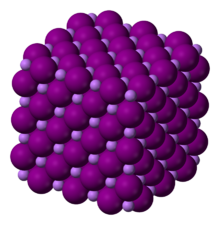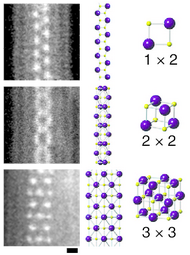Chemistry:Lithium iodide
 | |

| |
| Identifiers | |
|---|---|
| |
3D model (JSmol)
|
|
| ChemSpider | |
PubChem CID
|
|
| UNII |
|
| |
| |
| Properties | |
| LiI | |
| Molar mass | 133.85 g/mol |
| Appearance | White crystalline solid |
| Density | 4.076 g/cm3 (anhydrous) 3.494 g/cm3 (trihydrate) |
| Melting point | 469 °C (876 °F; 742 K) |
| Boiling point | 1,171 °C (2,140 °F; 1,444 K) |
| 1510 g/L (0 °C) 1670 g/L (25 °C) 4330 g/L (100 °C) [1] | |
| Solubility | soluble in ethanol, propanol, ethanediol, ammonia |
| Solubility in methanol | 3430 g/L (20 °C) |
| Solubility in acetone | 426 g/L (18 °C) |
| −50.0·10−6 cm3/mol | |
Refractive index (nD)
|
1.955 |
| Thermochemistry | |
Heat capacity (C)
|
0.381 J/g K or 54.4 J/mol K |
Std molar
entropy (S |
75.7 J/mol K |
Std enthalpy of
formation (ΔfH⦵298) |
-2.02 kJ/g or −270.48 kJ/mol |
Gibbs free energy (ΔfG˚)
|
-266.9 kJ/mol |
| Hazards | |
| Safety data sheet | External MSDS |
| NFPA 704 (fire diamond) | |
| Flash point | Non-flammable |
| Related compounds | |
Other anions
|
Lithium fluoride Lithium chloride Lithium bromide Lithium astatide |
Other cations
|
Sodium iodide Potassium iodide Rubidium iodide Caesium iodide Francium iodide |
Except where otherwise noted, data are given for materials in their standard state (at 25 °C [77 °F], 100 kPa). | |
| Infobox references | |
Lithium iodide, or LiI, is a compound of lithium and iodine. When exposed to air, it becomes yellow in color, due to the oxidation of iodide to iodine.[2] It crystallizes in the NaCl motif.[3] It can participate in various hydrates.[4]
Applications

Lithium iodide is used as a solid-state electrolyte for high-temperature batteries. It is also the standard electrolyte in artificial pacemakers[6] due to the long cycle life it enables.[7] The solid is used as a phosphor for neutron detection.[8] It is also used, in a complex with Iodine, in the electrolyte of dye-sensitized solar cells.
In organic synthesis, LiI is useful for cleaving C-O bonds. For example, it can be used to convert methyl esters to carboxylic acids:[9]
- RCO2CH3 + LiI → RCO2Li + CH3I
Similar reactions apply to epoxides and aziridines.
Lithium iodide was used as a radiocontrast agent for CT scans. Its use was discontinued due to renal toxicity. Inorganic iodine solutions suffered from hyperosmolarity and high viscosities. Current iodinated contrast agents are organoiodine compounds.[10]
See also
References
- ↑ Patnaik, Pradyot (2002) Handbook of Inorganic Chemicals. McGraw-Hill, ISBN:0-07-049439-8
- ↑ "Lithium iodide". ESPI Corp. MSDS. http://www.espimetals.com/msds's/lithiumiodide.pdf.
- ↑ Wells, A.F. (1984) Structural Inorganic Chemistry, Oxford: Clarendon Press. ISBN:0-19-855370-6.
- ↑ Wietelmann, Ulrich and Bauer, Richard J. (2005) "Lithium and Lithium Compounds" in Ullmann's Encyclopedia of Industrial Chemistry, Wiley-VCH: Weinheim. doi:10.1002/14356007.a15_393.
- ↑ Senga, Ryosuke; Suenaga, Kazu (2015). "Single-atom electron energy loss spectroscopy of light elements". Nature Communications 6: 7943. doi:10.1038/ncomms8943. PMID 26228378. Bibcode: 2015NatCo...6.7943S.
- ↑ Holmes, C. (2007-09-28). "The Lithium/Iodine-Polyvinylpyridine Pacemaker Battery - 35 years of Successful Clinical Use" (in en). ECS Transactions 6 (5): 1–7. doi:10.1149/1.2790382. ISSN 1938-5862. Bibcode: 2007ECSTr...6e...1H. https://iopscience.iop.org/article/10.1149/1.2790382/meta.
- ↑ Hanif, Maryam (2008). "The Pacemaker Battery - Review Article". UIC Bioengineering Student Journal.
- ↑ Nicholson, K. P. (1955). "Some lithium iodide phosphors for slow neutron detection". Br. J. Appl. Phys. 6 (3): 104–106. doi:10.1088/0508-3443/6/3/311. Bibcode: 1955BJAP....6..104N.
- ↑ Charette, André B.; Barbay, J. Kent and He, Wei (2005) "Lithium Iodide" in Encyclopedia of Reagents for Organic Synthesis, John Wiley & Sons. doi:10.1002/047084289X.rl121.pub2
- ↑ Lusic, Hrvoje; Grinstaff, Mark W. (2013). "X-ray-Computed Tomography Contrast Agents". Chemical Reviews 113 (3): 1641–66. doi:10.1021/cr200358s. PMID 23210836.
External links
- "WebElements – Lithium Iodide". https://www.webelements.com/compounds/lithium/lithium_iodide.html.
- "Composition of Lithium Iodide – NIST". http://physics.nist.gov/cgi-bin/Star/compos.pl?matno=187.
| HI | He | ||||||||||||||||
| LiI | BeI2 | BI3 | CI4 | NI3 | I2O4, I2O5, I4O9 |
IF, IF3, IF5, IF7 |
Ne | ||||||||||
| NaI | MgI2 | AlI3 | SiI4 | PI3, P2I4 |
S | ICl, ICl3 |
Ar | ||||||||||
| KI | CaI2 | Sc | TiI4 | VI3 | CrI3 | MnI2 | FeI2 | CoI2 | NiI2 | CuI | ZnI2 | Ga2I6 | GeI2, GeI4 |
AsI3 | Se | IBr | Kr |
| RbI | SrI2 | YI3 | ZrI4 | NbI5 | Mo | Tc | Ru | Rh | Pd | AgI | CdI2 | InI3 | SnI4, SnI2 |
SbI3 | TeI4 | I | Xe |
| CsI | BaI2 | HfI4 | TaI5 | W | Re | Os | Ir | Pt | AuI | Hg2I2, HgI2 |
TlI | PbI2 | BiI3 | Po | AtI | Rn | |
| Fr | RaI2 | Rf | Db | Sg | Bh | Hs | Mt | Ds | Rg | Cn | Nh | Fl | Mc | Lv | Ts | Og | |
| ↓ | |||||||||||||||||
| La | Ce | Pr | Nd | Pm | SmI2 | Eu | Gd | TbI3 | Dy | Ho | Er | Tm | Yb | Lu | |||
| Ac | ThI4 | Pa | UI3, UI4 |
Np | Pu | Am | Cm | Bk | Cf | EsI3 | Fm | Md | No | Lr | |||
 |

